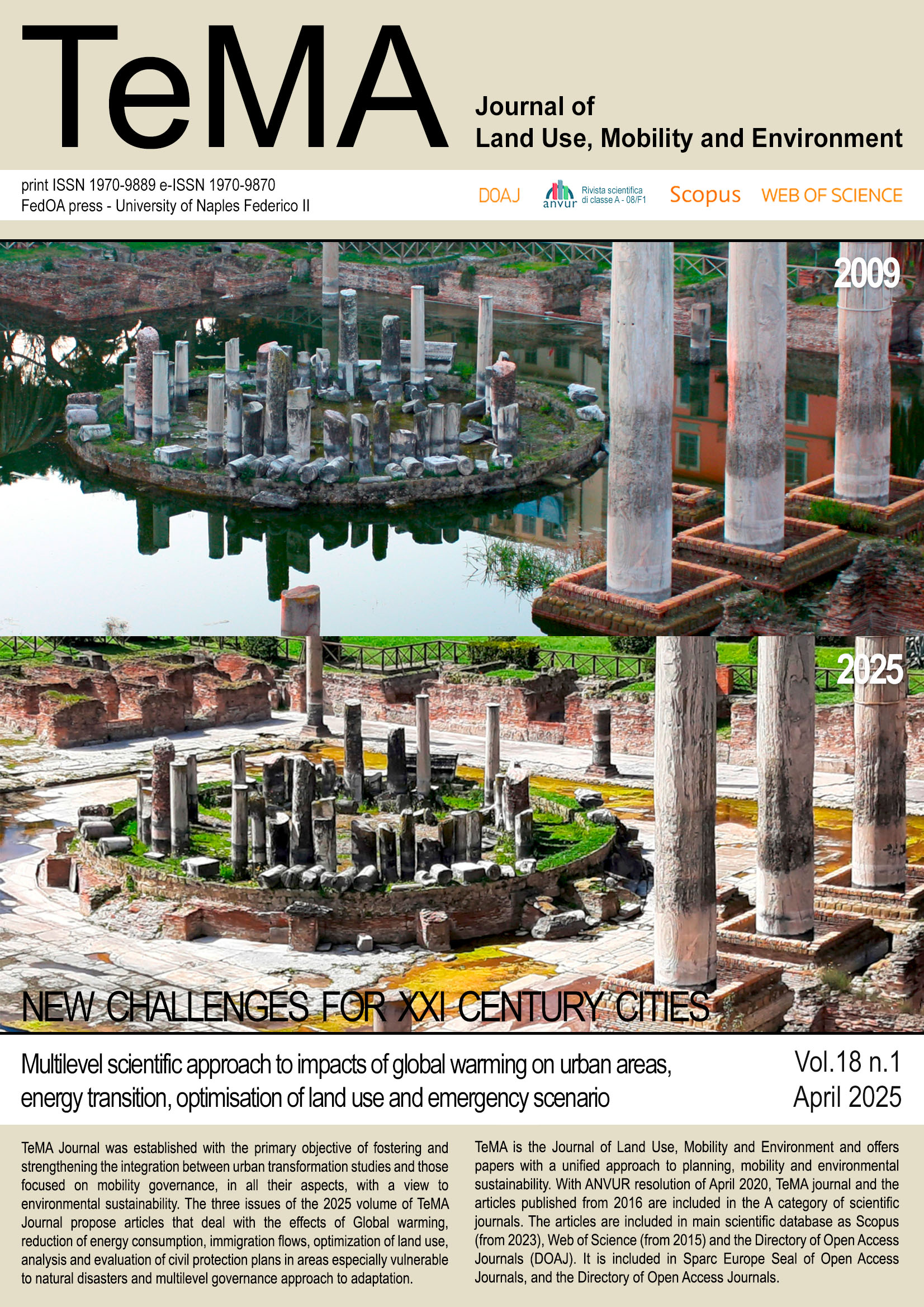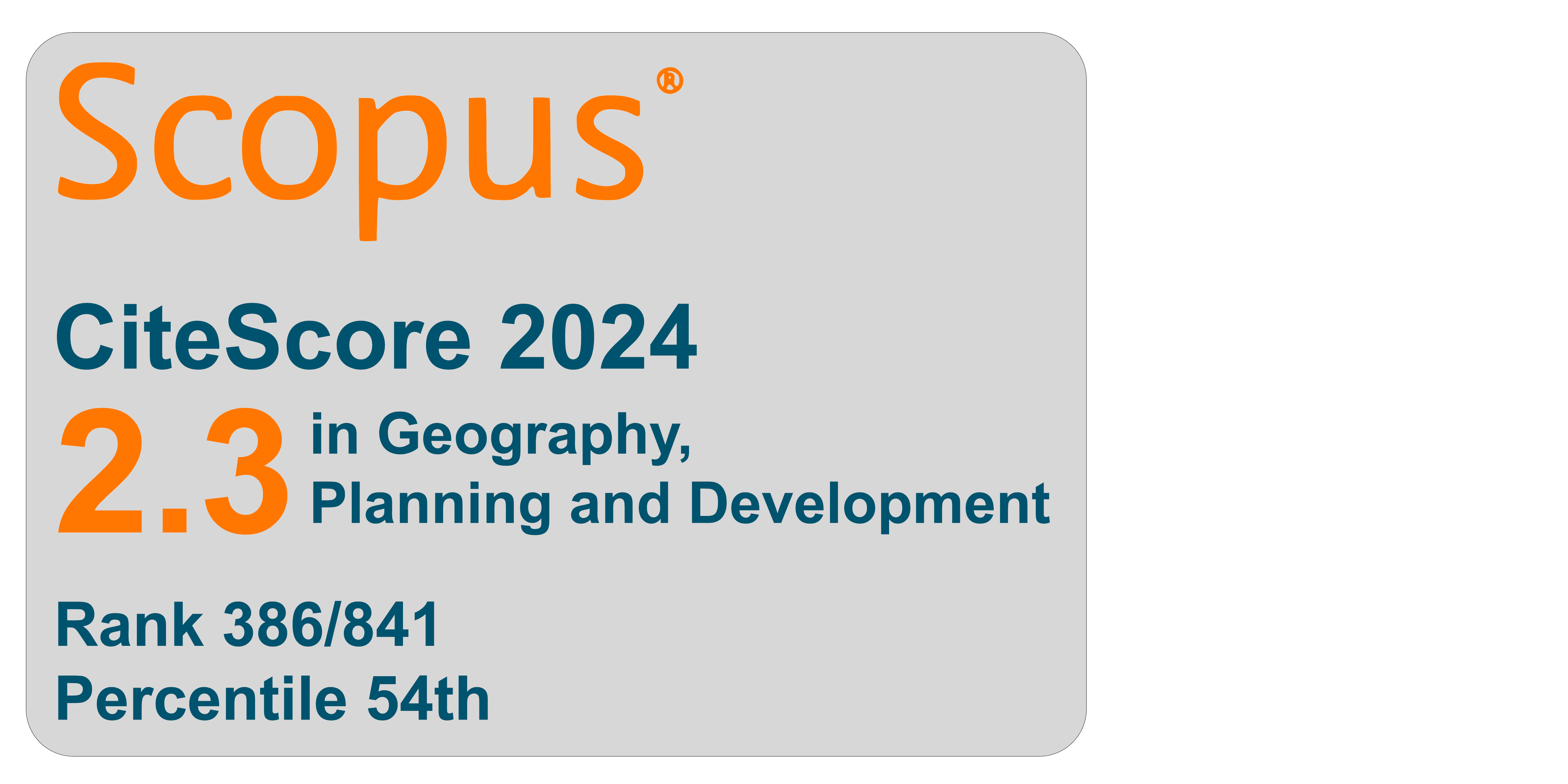Revitalising abandoned historical districts. Application of an incremental and adaptive approach to regeneration
DOI:
https://doi.org/10.6093/1970-9870/11114Keywords:
Urban ecosystem, Spatial arrangement, Open space systems, Urban Planning, Cityforming ProtocolAbstract
Urban regeneration in historical contexts must integrate physical restoration with socio-economic revitalization. This study examines the regeneration of an abandoned area in Palermo’s historic centre, altered by degradation and marginalization. Developed through a research agreement between the Confraternity of the "Unione del Miseremini" and the Department of Architecture at UNIPA, the study proposes a socio-economic regeneration plan. The research addresses the challenge of balancing heritage conservation with contemporary urban innovation. Previous approaches have often overlooked the need for integrated strategies. This study applies the Cityforming Protocol, an incremental methodology that reconnects urban infrastructures (blue, green, grey, brown, and red systems) to restore urban metabolism. Through dynamic mapping and strategic guidelines, it fosters adaptive and inclusive regeneration. Findings highlight that reactivating latent urban elements, leveraging governance frameworks, and engaging communities enhance sustainable regeneration. The study provides a holistic approach for revitalizing historic centres as socio-economic hubs, offering insights for policymakers and urban planners.
Downloads
References
Bai, X., Surveyer, A., Elmqvist, T., Gatzweiler, F. W., Güneralp, B., Parnell, S., Prieur-Richard, A. H., Shrivastava, P., Siri, J. G., Stafford-Smith, M., Toussaint, J. P. & Webb, R. (2016). Defining and advancing a systems approach for sustainable cities. Current Opinion in Environmental Sustainability, 23, 69–78. https://doi.org/10.1016/J.COSUST.2016.11.010
Boglietti, S. & Tiboni, M. (2022). Public spaces critical issues analysis for soft mobility. TeMA - Journal of Land Use, Mobility and Environment, 131-145. https://doi.org/10.6093/1970-9870/8643
Carta, M. (2015). Iper-strategie del riciclo: Cityforming © Protocol. In M. Carta & B. Lino (Eds.), Urban Hyper-Metabolism. Aracne Internazionale.
Carta, M. (2021a). Città aumentate. Dieci gesti-barriera per il futuro. Il Margine.
Carta, M. (2021b). Palermo: biografia progettuale di una città aumentata. LetteraVentidue.
Carta, M. (2023). Palermo, un’idea di cui è giunto il tempo. Marsilio.
Carta, M. (2024). Romanzo urbanistico: Storie dalle città del mondo. Sellerio Editore.
Carta, M., La Greca, P., Ronsivalle, D. & Lino, B. (2025). Planning Complex Waterfront Interfaces: reshaping Port City Regeneration for Sustainable Urban Futures. Springer Nature.
Carta, M., Lino, B. & Ronsivalle, D. (2017). Re-cyclical Urbanism. Visions, Paradigms and Projects for the Circular Metamorphosis. ListLab.
Carta, M. & Ronsivalle, D. (2015). Territori Interni. La Pianificazione Integrata per lo sviluppo circolare: metodologie, approcci, applicazioni per nuovi cicli di vita. Aracne Internazionale.
Carta, M., Ronsivalle, D. & Lino, B. (2020). The Good Practice Framework for European Sustainable Urbanisation through port city Regeneration. An operative guide. Espon publisher. Retrieved from https://archive.espon.eu/sites/default/files/ attachments/Annex%205%20-%20ENSURE-Good%20practice%20framework.pdf (accessed 10/02/2025)
Carta, M., Ronsivalle, D., Lino, B. & Contato, A. (2024). Sicani living future: processi di sviluppo incrementale e adattivo nell’orizzonte del 2040. Unipa press.
Casanova, H. & Hernandez, J. (2014). Public Space Acupuncture: Strategies and Interventions for Activating City Life. Actar Publishers.
Ceci, M., Caselli, B. & Zazzi, M. (2023). Soil de-sealing for cities’ adaptation to climate change. TeMA - Journal of Land Use, Mobility and Environment, 16 (1), 121-145. https://doi.org/10.6093/1970-9870/9395
Chester, M. V. (2019). Sustainability and infrastructure challenges. Nature Sustainability, 2 (4), 265–266. https://doi.org/10.1038/s41893-019-0272-8
Coccia, E. (2018). La vita delle piante: metafisica della mescolanza. Società editrice il Mulino.
Cucinella, M. (2018). Arcipelago Italia. Progetti per il futuro dei territori interni del Paese. Padiglione Italia alla Biennale Architettura 2018. Quodlibet.
Dawson, R. J., Thompson, D., Johns, D., Wood, R., Darch, G., Chapman, L., Hughes, P. N., Watson, G. V. R., Paulson, K., Bell, S., Gosling, S. N., Powrie, W. & Hall, J. W. (2018). A systems framework for national assessment of climate risks to infrastructure. Philosophical Transactions of the Royal Society A: Mathematical, Physical and Engineering Sciences, 376 (2121), 20170298. https://doi.org/10.1098/rsta.2017.0298
De Carlo, G., Di Cristina, U., Samonà, G. & Sciarra Borzì, A. (1983). Palermo. Piano Programma del Centro Storico. Supplemento di Progettare - rivista trimestrale.
Francini, M., Chimirri, R., Palermo, A. & Francesca, V. (2017). Between Community Spaces: Squares of Minor Centers of Calabria. TeMA - Journal of Land Use, Mobility and Environment, 10 (2), 157–178. https://doi.org/10.6092/1970-9870/5087
Hall E. (1966) The Hidden Dimension. Doubleday
Ingaramo, R. & Negrello, M. (2024). Strategies for adapting the dense Italian cities to the climate change. TeMA - Journal of Land Use, Mobility and Environment, (1), 115-136. https://doi.org/10.6093/1970-9870/10212
Martinotti, G. (2017). Sei lezioni sulla città (S. Vicari Haddock, Ed.). Feltrinelli Editore.
Pörtner, H., Roberts, D., Tignor, M., Poloczanska, E., Mintenbeck, K., Alegría, A., Craig, M., Langsdorf, S., Löschke, S., Möller, V., Okem, A., Rama, B., Adams, H., Adelekan, I., Adler, C., Adrian, R., Aldunce, P., Ali, E., Ara Begum, R., … Sukumar, R. (2022). Climate Change 2022: Impacts, Adaptation and Vulnerability Working Group II Contribution to the IPCC Sixth Assessment Report Citations to the Sixth Assessment Report of the Intergovernmental Panel on Climate Change [ to the Sixth Assessment Report of the . https://doi.org/10.1017/9781009325844.Front
Punziano, G. & Terracciano, A. (2017). Urban Voids: renewal and regeneration experiences in Naples. TeMA - Journal of Land Use, Mobility and Environment, 10 (3), 299-323. https://doi.org/10.6092/1970-9870/5171
Rees, T., Bosch, T. & Douglas, A. E. (2018). How the microbiome challenges our concept of self. PLOS Biology, 16 (2), e2005358. https://doi.org/10.1371/journal.pbio.2005358
Ronsivalle, D. (2018). Luoghi, territori, paesaggi. Intelligenze collettive per la pianificazione del Neoantropocene. Franco Angeli. https://www.francoangeli.it/Home.aspx
Salat, S. & Bourdic, L. (2012). Systemic Resilience of Complex Urban Systems. TeMA - Journal of Land Use, Mobility and Environment, 5 (2), 55-68. https://doi.org/10.6092/1970-9870/918
Schillaci, T. (2021). La relazione con l’altro in filosofia e biologia: Le sfide interpretative poste dalla microbiomica al concetto di individuo. https://www.treccani.it/magazine/chiasmo/scienze_della_vita/Relazione/relazione_iuss_la_relazione_con _laltro_in_filosofia_e_biologia.html
Sonkoly, G. (2017) Historical Urban Landscape. London, Palgrave Macmillan.
UNESCO (2011) Recommendation on the Historic Urban Landscape (36 C/Resolution 41). Available online at: http://portal.unesco.org/en/ev.php-URL_ID=48857&URL_DO=DO_TOPIC&URL_SECTION=201.html (05/02/2025).
UNESCO (2013) New Life for Historic Centres. Paris, UNESCO.
Downloads
Published
How to Cite
Issue
Section
License
Copyright (c) 2025 TeMA - Journal of Land Use, Mobility and Environment

This work is licensed under a Creative Commons Attribution-NonCommercial 4.0 International License.



